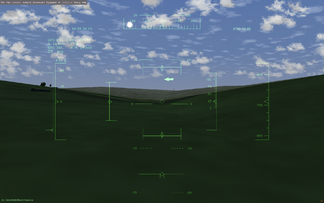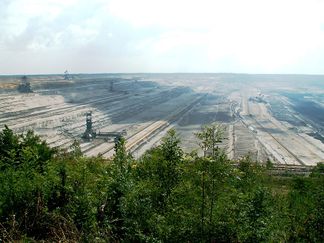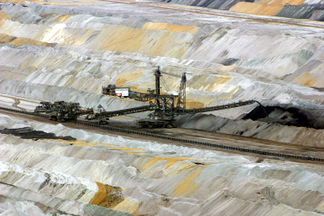Rheinisches Braunkohlerevier
The Rheinische Braunkohlerevier (german for 'lignite region in Rhineland') is an region near Cologne, Germany. A lot of lignite is extracted here and converted to electricity. There are several opencast mines with powerplants next to them.
Since the region is visible from LEO, it is important to represent it properly in FlightGear Scenery. Though some pits were captured by SRTM radar mapping, they aren't to distinguish from usual landscape.
Actually the area is defined by giant pits, artifical hills, lakes as well as huge powerplants with cooling towers and ascent channels.
POI of the region
The industries of that region brought up several world records, some of them are relevant to scenery. For example, the Hambacher Loch is the biggest artifical hole of the world, while the Sophienhoehe is the tallest artifical hill. The biggest excavators of the world are used there, and the tallest cooling tower as well. These things are easily visible from air, so they should become included to FlightGear. File:FGFS-HambacherLoch001.png
Opencast Pits
The Hambacher Loch (50° 54′ 39″ N, 6° 30′ 10″ O) is the biggest opencast pit in the Rheinische Braunkohlerevier. It has a size of more than 40 km² and a max. depth of 370 m. This means its bottom lies 293 m below sea level.
Not far from that is Tagebau Garzweiler, 23 km² sized and 160 m deep and Tagebau Inden with 13 km². They are much smaller in comparison, but still have a diameter of some kilometers.
Inside all of them are several Excavators, its appearance is mostly dark, due to the lignite (and its dust). This is not represented by the textures yet, which represent agriculture.
Excavators
There are at least nine major Excavators in service in the opencast pits. The biggest ones have a mass 14,000 tons, a length of 225 m and a height of 95 m - easy to spot. They excavate up to 240,000 m³ per day.
TASK: Create the models, place them in their pits. Animate them.
| Identifier | Pit | Mass | Length | Height | Maintainer | Progress |
|---|---|---|---|---|---|---|
| Bagger 255 | Inden | 5,900 t | 210 m | 66 m | ||
| Bagger 259 | Garzweiler | 7,800 t | 210 m | 70 m | ||
| Bagger 260 | Hambach | 7,800 t | 195 m | 67 m | ||
| Bagger 261 | Garzweiler | 7,386 t | 220 m | 60 m | ||
| Bagger 262 | Garzweiler | ? t | 195 m | 67 m | ||
| Bagger 285 | Garzweiler | 13,500 t | 210 m | 92 m | ||
| Bagger 287 | Hambach | 14,000 t | 225 m | 95 m | ||
| Bagger 288 | Garzweiler | 12,840 t | 220 m | 96 m | ||
| Bagger 293 | Hambach | 14,200 t | 225 m | 96 m |
Powerplants
Due to their Ascent and Cooling Towers, powerplants are important landmarks. They huge cooler steam cloud is typically visible from far away.
Task: Create Table for plants (?) Tasks: Model and place the plants among with its periphery
Niederaußem, 3,627 MW
Ascent Channels: 2 x 160 m, 3 x 130 m, 2 x 100 m
Cooler Towers: 1 x 200 m, 2 x 128 m, 3 x 106 m, 6 x 40 m
Neurath, 2,200 MW
Ascent Channels: 2 x 170 m, 3 x 160 m
Cooler Towers: 2 x 128 m, 3 x 103 m
Frimmersdorf, 2,136 MW
Ascent Channels: 1 x 200m, 3 x 160m
Cooler Towers: ?
Weisweiler, 2,100 MW
Ascent Channels: 2 x 168 m
Cooler Towers: ?
Sophienhöhe
Sophienhöhe (50° 55′ 55″ N, 6° 26′ 56″ O) is a hill made of excavated material, it reaches a hight of 200 m, still growing. As the region is relatively flat, it is very noticeable.



